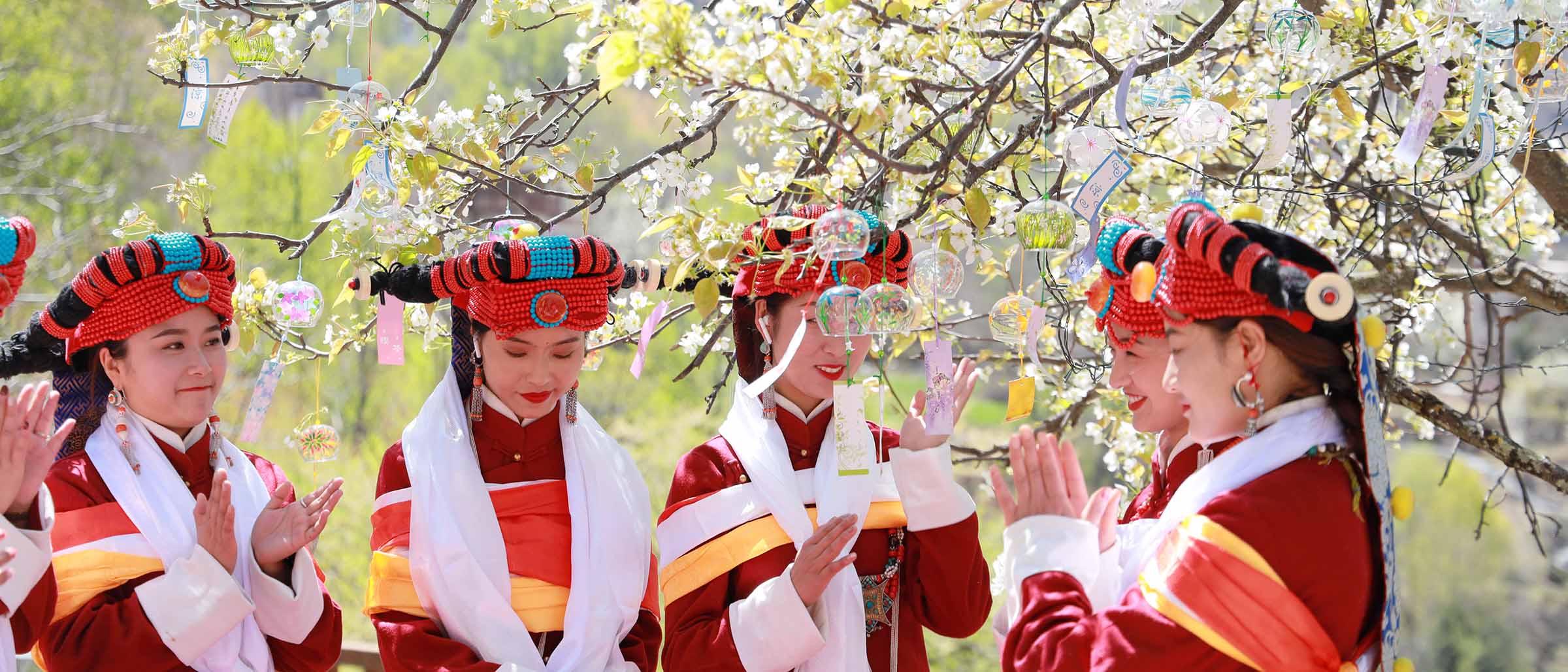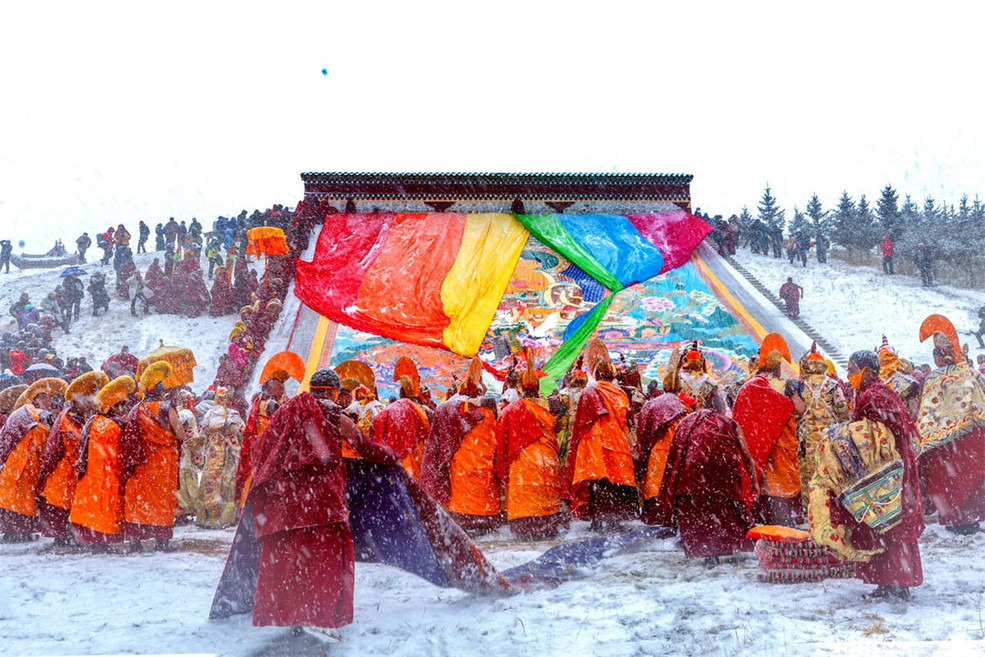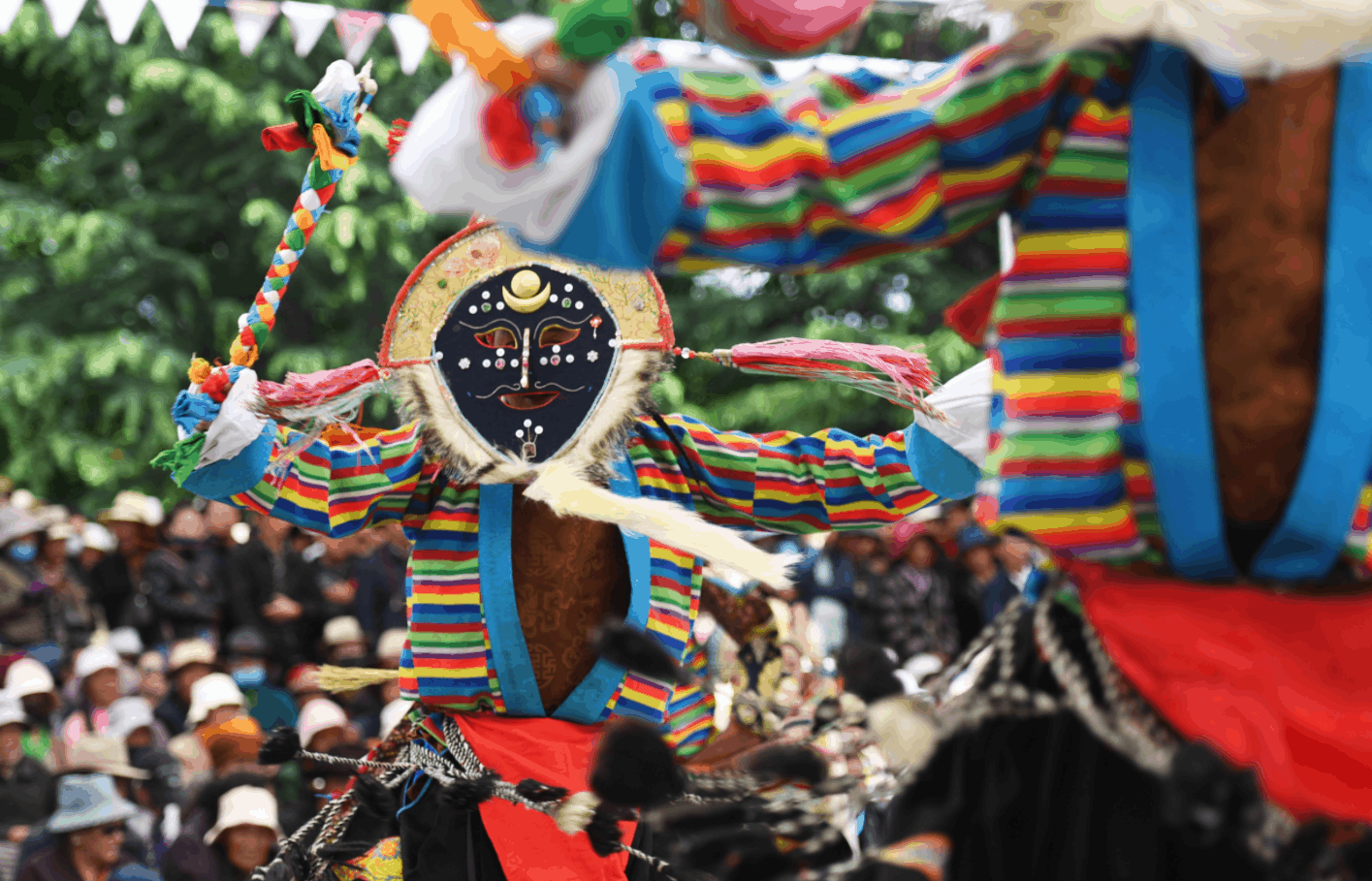Festival serves as a bridge into the soul of an ethnic group. Festivals are generally held in certain seasons, but the contents are all-embracing. Especially some grand festivals which thoroughly reflect regional politics and economy, production and living, religion and belief, culture and arts, social interaction and so forth. In addition to national festivals, different regions have their own unique regional festivals. Such as the Tibetans, one of China's ethnic minorities, have great talent in singing and dancing and enjoy various kinds of social activities. As an important platform for social events, Tibetan festivals take place almost every month. Some last for one or two days, while some would be celebrated for more than ten days.

Sho Dun Festival
The Sho Dun Festival is one of the most popular traditional festivals in Tibet. "Sho Dun" means yoghurt banquet. In Tibetan language, "sho" means yoghurt, and "Dun" means banquet. Therefore, it is the festival of eating yoghurt. In additon, there are Tibetan opera performances and Buddhist basking ceremonies during the Sho Dun Festival, thus some people also call it "Tibetan Opera Festival" or "Buddha Exhibition Festival". It is held annually late in the sixth month or early in the seventh month of the Tibetan calendar. The Sho Dun Festival has become a market time, and a time for competitions, performances and entertainment.
On the first day, the Thangka is to be unveiled at the Drepung Monastery. Then the celebrations will begin at Norbulingka. Residents in Lhasa will gather in the park and celebrate by eating yoghurt and watching operas. Professional and amateur Tibetan opera troupes gather in the Norbulingka and perform various Tibetan operas annually. Along with Tibetan operas and other religious activities, visitors can also watch yak races, horse races and dance.
Monlam prayer festival
The Monlam prayer festival is actually almost a two week event. It starts on the 1st day of the Tibetan year that is the Tibetan New Year Festival called Losar and ends on the 15th day on the night of the full moon called the Butter Lamp Festival which is the greatest day of the Monlam Festival. During the festival, Buddhists pray and commemorate the miracles Buddha did about 2,500 years ago in India. It is said by many that the goal of the festival is to pray for the long life of all holy gurus of all traditions, for the survival and spreading of Buddha’s teachings in the minds of all sentient beings, and for world peace.
In the temples, people will light butter lamps. Butter lamps are simply clarified yak butter or vegetable oil in a bowl with a wick. In Tibetan Buddhist tradition, putting a lot of lights together are conducive for meditation and mind-focusing. According to the Root Tantra of Chakrasamvara, "If you wish for sublime realization, offer hundreds of lights.” So on special holidays, people and monks would light thousands of lamps at temples.
During the festival, Tibetans listen to teachings and donate to monasteries, monks and Buddhist nuns. They also engage in making merry. A good place to see this is Barkhor Street in Lhasa where traditional buildings and the most important Tibetan Buddhist temple called Jokhang Temple stand.
Horse Racing Festival
Imagine a vast expanse of grassland at 4,000 meters above sea level. Imagine the Khampas, a lively tribe of nomadic warriors, in their festive finery. Imagine horse races, crazy stunts, and traditional song and dance. Imagine a Tibetan version of Woodstock with horses. That is the Litang Horse Racing Festival.
The Horse Racing Festival in Litang is known as the most brilliant and magnificent one across the whole Tibetan area. It’s more than horse racing yet a plateau gala to understand Tibetans profoundly. Before 2008, August 1st was annually the first day of the 3 days long Litang Horse Racing Festival which took place in Litang county. Tibetans come from all over Kham, Amdo and central Tibet setting up their tents on the enormous grassland of Litang which makes the pasture a “City of Tent”. During the racing festival, brave riders will show the audience their skills of horseback riding, shooting or archery on the fast running horseback, etc. All men and women would wear their most beautiful ethnic costumes with precious jewelry. Besides, it is also a good time for trade, various kinds of Tibetan living wares would be put on stands for sale.
Torch Festival
Torch Festival or Fire Festival is widely celebrated among the people of Yi, Bai, Naxi, Hani, Lahu, Pumi and some other ethnic groups in southwest China. During the 2-or-3-day festival, people enjoy a couple of exciting nights of fire, dancing in fields or on the streets of counties, lighting up the sky with thousands of burning torches, followed by other enthusiastic activities like bull fighting, horse riding, wrestling, dancing and singing performances. This hopping festival has earned the reputation of “the oriental Carnival”.
“The oriental Carnival” always occurs in June of the Chinese lunar calendar, corresponding to August in the Gregorian calendar. However, days around the 25th, different groups have slightly different celebration purposes and traditional activities. The "Liangshan Prefecture Torch Festival of Yi" on the 24th is the most grand event, and it is the New Year's Day for Yi people. To commemorate the day and pray for a good harvest, kids and the aged would dance around the fields with torches in their hands while the young sow seeds in the fields which is a rare-seen and fantastic celebration mixed with agriculture activities. In addition, people also dance around a huge bonfire.
Lusheng Festival
The Lusheng festival is the most characteristic festival of the Miao (Hmong) ethnic minority, and it is celebrated wherever there are Miao people, the largest and most well-known Lusheng celebration is in Kaili, Guizhou province. Lusheng is a bamboo woodwind instrument with a versatile range, making it the perfect instrument to accompany a wide variety of traditional activities such as Miao dancing and acrobatics. Not surprisingly, the Lusheng festival is to celebrate this instrument. Miao people would come from surrounding villages and gather together in the Lusheng arena, wearing their finest ethnic costumes, including silver headdresses for women. Song and dance are often part of the traditional courtship rituals of the Miao, and the Lusheng festival is a great time for young Miao ladies to meet eligible young Miao men, while also enjoying the celebration.
Nyingchi Peach Blossom Festival
When spring approaches, most parts of Tibet are still covered with snow, but Nyingchi has already been immerged in a sea of peach flowers. In order to celebrate this grandeur of nature and advocate Tibetan culture, Nyingchi Peach Blossom Festival has been held by local Tibetans and enthusiastic tourists since 2002. During this grand festival, tourists could not only enjoy the rosy peach blossoms and exotic pastoral scenery, but also explore Tibetan villages, watch horsemanship performance, try some local delicacies, etc.
The opening date of Nyingchi Peach Blossom Festival is not fixed. It depends on the blooming season of peach blossoms of the year. According to the past years’ records, the festival mostly started in late March. Some top recommended places for appreciating the best peach blossom: Bome County, Zayu County, Bayi District, Gala Village, Nyang River and Yarlung Zangbu Grand Canyon.

- $548.00
- 6D5N DAYS
01. Visit Dujiangyan Irrigation System, explore the oldest and only surviving no-dam irrigation system in the world; and a wonder in the development of Chinese science.02. The famous place to enjoy the blossom of snow pear flowers in Jinchua…
Read More
- $1198.00
- 9D8N DAYS
01. Monlam Festival (or The Great Prayer Festival) is the grandest religious festival in Tibet, the 10-Day Amdo Tibetan Monlam Festival tour offers you an opportunity to attend festival events with thousands of local Tibetan nomads, you can …
Read More
- $680.00
- 8D7N DAYS
01. Have a walk in the believed-to-be “Paradise of Photographers” Xinduqiao to experience local Khampa Tibetan landscape and local people,enjoying the endless sub-alpine meadow, scattered yaks in Xinduqiao.02. Visiting the highest town in …
Read More
- $1280.00
- 7D6N DAYS
01. Specially arrange a 3days tour in Lhasa to hava a deep experience of the various kinds of Tibetan Culture, also a very good opportunity to shoot the local people.02. Count the steps up to the Potala Palace — the holy palace of Tibetan B…
Read More